coolant temperature LINCOLN MKZ 2014 Owners Manual
[x] Cancel search | Manufacturer: LINCOLN, Model Year: 2014, Model line: MKZ, Model: LINCOLN MKZ 2014Pages: 468, PDF Size: 4.49 MB
Page 11 of 468
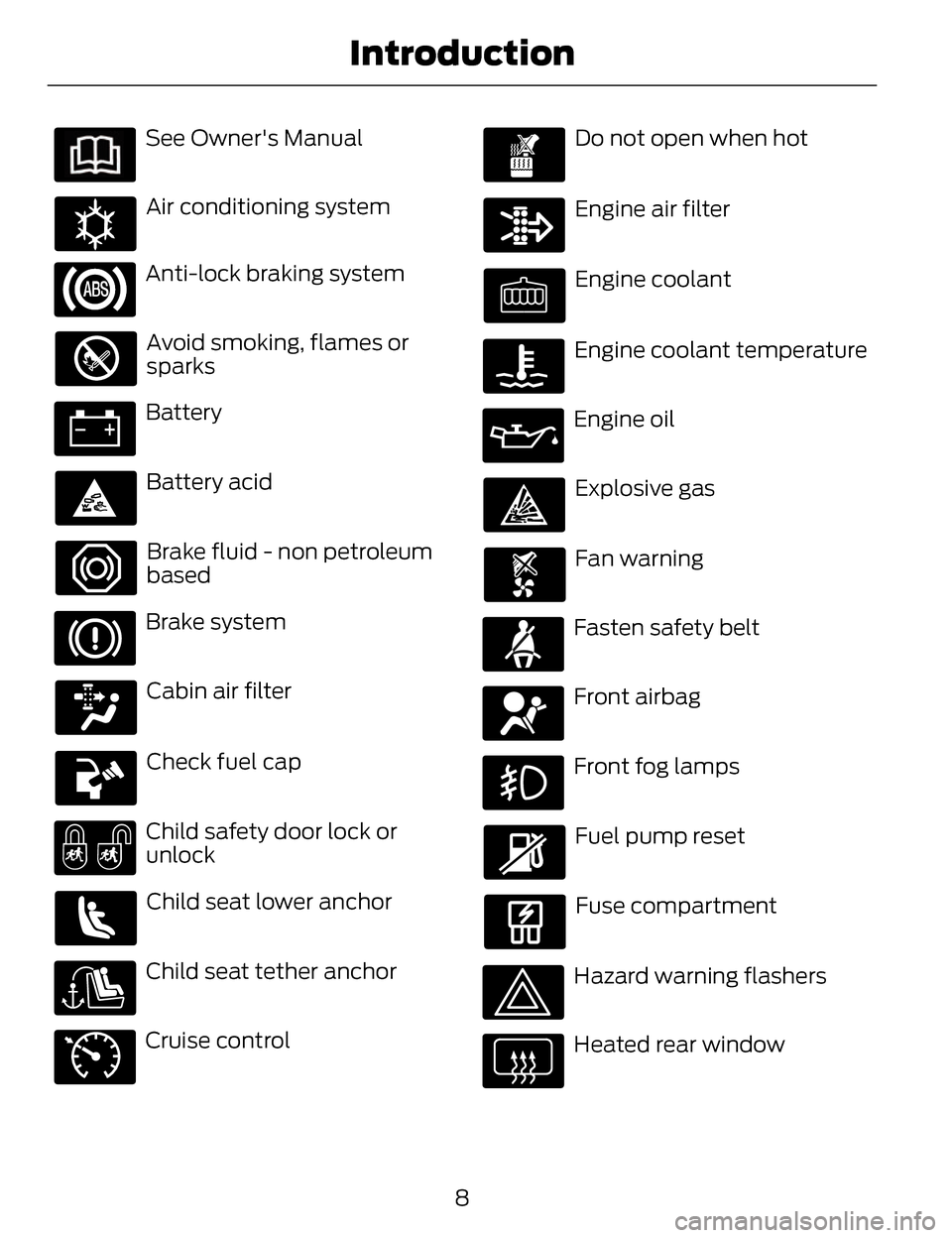
See Owner's Manual
E162384
Air conditioning system
Anti-lock braking system
Avoid smoking, flames or
sparks
Battery
Battery acid
Brake fluid - non petroleum
based
Brake system
Cabin air filter
Check fuel cap
Child safety door lock or
unlock
Child seat lower anchor
Child seat tether anchor
E71340
Cruise control
Do not open when hot
Engine air filter
Engine coolant
Engine coolant temperature
Engine oil
Explosive gas
Fan warning
Fasten safety belt
Front airbag
Front fog lamps
Fuel pump reset
Fuse compartment
Hazard warning flashers
Heated rear window
8
Introduction
Page 98 of 468
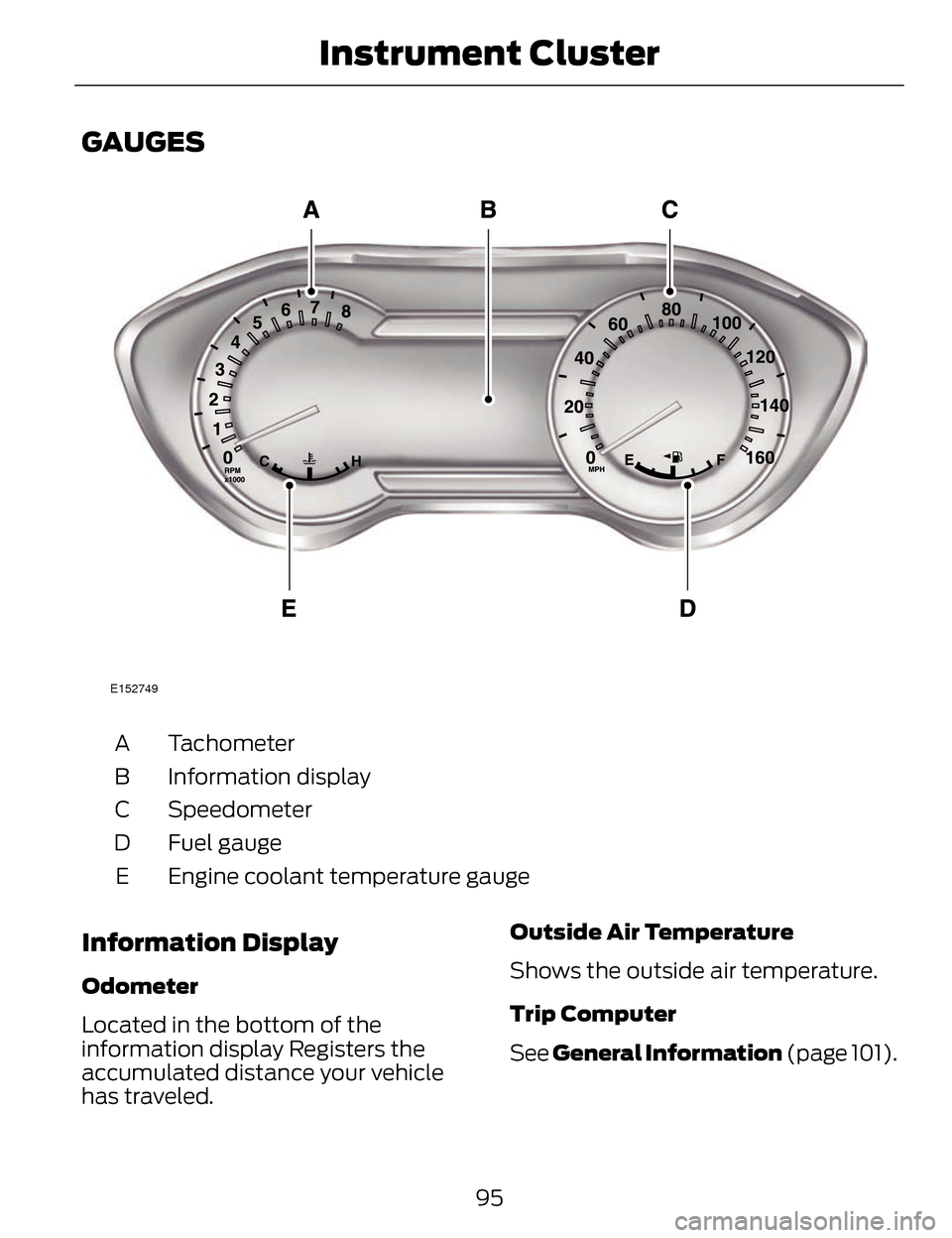
GAUGES
E152749
Tachometer
A
Information display
B
Speedometer
C
Fuel gauge
D
Engine coolant temperature gauge
E
Information Display
Odometer
Located in the bottom of the
information display Registers the
accumulated distance your vehicle
has traveled. Outside Air Temperature
Shows the outside air temperature.
Trip Computer
See
General Information (page 101).
95
Instrument Cluster
Page 99 of 468
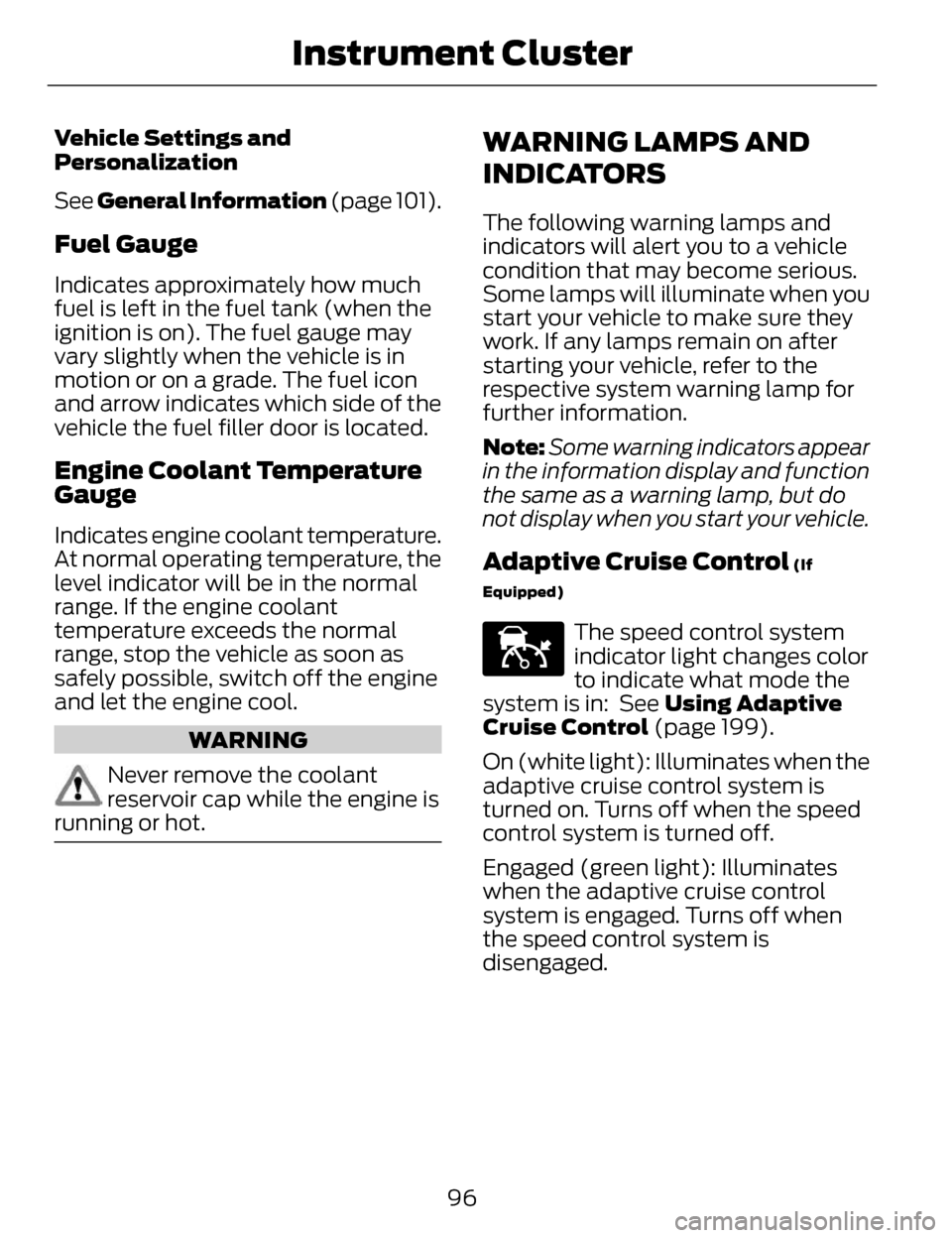
Vehicle Settings and
Personalization
See General Information (page 101).
Fuel Gauge
Indicates approximately how much
fuel is left in the fuel tank (when the
ignition is on). The fuel gauge may
vary slightly when the vehicle is in
motion or on a grade. The fuel icon
and arrow indicates which side of the
vehicle the fuel filler door is located.
Engine Coolant Temperature
Gauge
Indicates engine coolant temperature.
At normal operating temperature, the
level indicator will be in the normal
range. If the engine coolant
temperature exceeds the normal
range, stop the vehicle as soon as
safely possible, switch off the engine
and let the engine cool.
WARNING
Never remove the coolant
reservoir cap while the engine is
running or hot.
WARNING LAMPS AND
INDICATORS
The following warning lamps and
indicators will alert you to a vehicle
condition that may become serious.
Some lamps will illuminate when you
start your vehicle to make sure they
work. If any lamps remain on after
starting your vehicle, refer to the
respective system warning lamp for
further information.
Note: Some warning indicators appear
in the information display and function
the same as a warning lamp, but do
not display when you start your vehicle.
Adaptive Cruise Control (If
Equipped)
E144524
The speed control system
indicator light changes color
to indicate what mode the
system is in: See Using Adaptive
Cruise Control (page 199).
On (white light): Illuminates when the
adaptive cruise control system is
turned on. Turns off when the speed
control system is turned off.
Engaged (green light): Illuminates
when the adaptive cruise control
system is engaged. Turns off when
the speed control system is
disengaged.
96
Instrument Cluster
Page 101 of 468
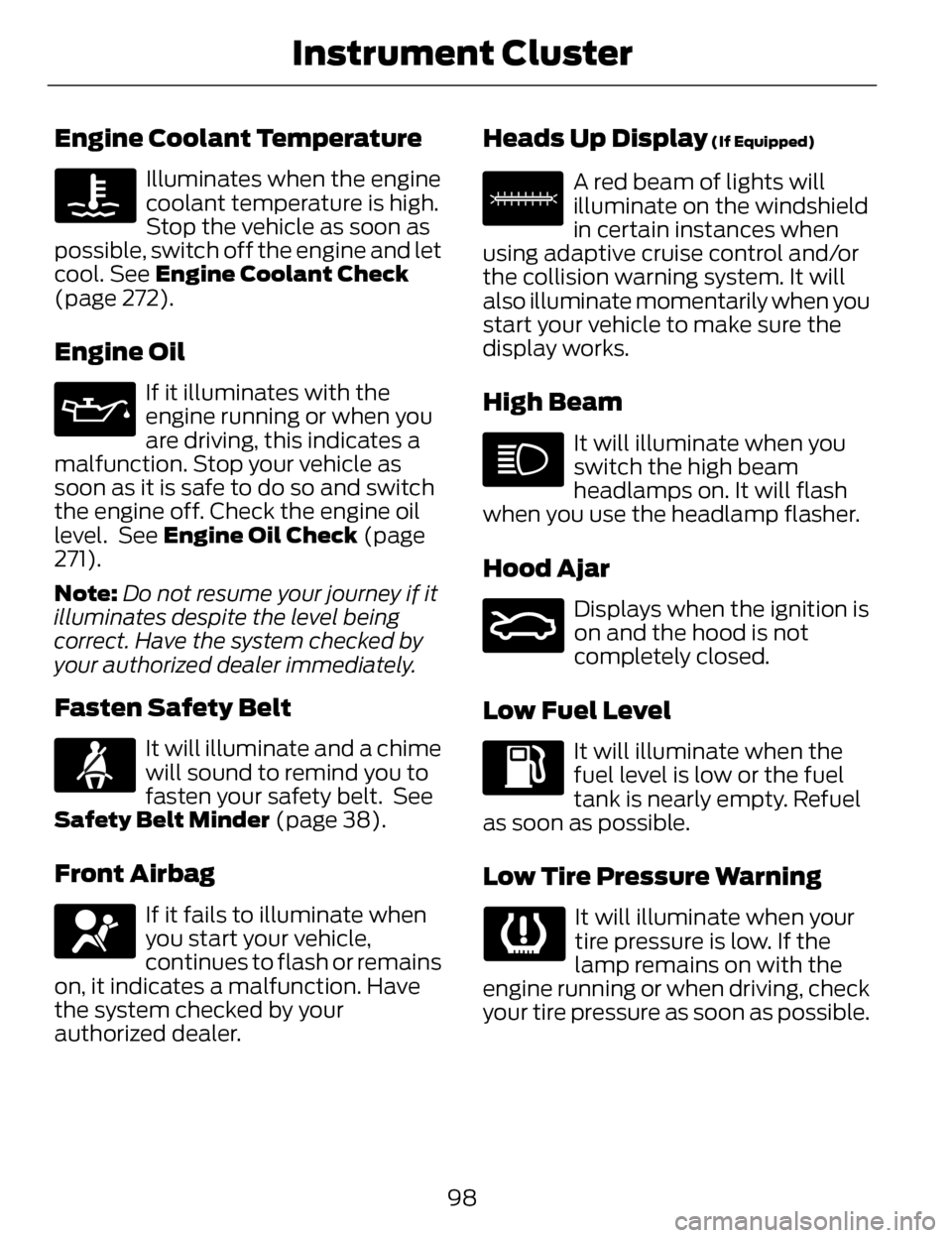
Engine Coolant Temperature
Illuminates when the engine
coolant temperature is high.
Stop the vehicle as soon as
possible, switch off the engine and let
cool. See Engine Coolant Check
(page 272).
Engine Oil
If it illuminates with the
engine running or when you
are driving, this indicates a
malfunction. Stop your vehicle as
soon as it is safe to do so and switch
the engine off. Check the engine oil
level. See Engine Oil Check (page
271).
Note: Do not resume your journey if it
illuminates despite the level being
correct. Have the system checked by
your authorized dealer immediately.
Fasten Safety Belt
It will illuminate and a chime
will sound to remind you to
fasten your safety belt. See
Safety Belt Minder (page 38).
Front Airbag
If it fails to illuminate when
you start your vehicle,
continues to flash or remains
on, it indicates a malfunction. Have
the system checked by your
authorized dealer.
Heads Up Display (If Equipped)
E156133
A red beam of lights will
illuminate on the windshield
in certain instances when
using adaptive cruise control and/or
the collision warning system. It will
also illuminate momentarily when you
start your vehicle to make sure the
display works.
High Beam
It will illuminate when you
switch the high beam
headlamps on. It will flash
when you use the headlamp flasher.
Hood Ajar
E159324
Displays when the ignition is
on and the hood is not
completely closed.
Low Fuel Level
It will illuminate when the
fuel level is low or the fuel
tank is nearly empty. Refuel
as soon as possible.
Low Tire Pressure Warning
It will illuminate when your
tire pressure is low. If the
lamp remains on with the
engine running or when driving, check
your tire pressure as soon as possible.
98
Instrument Cluster
Page 118 of 468
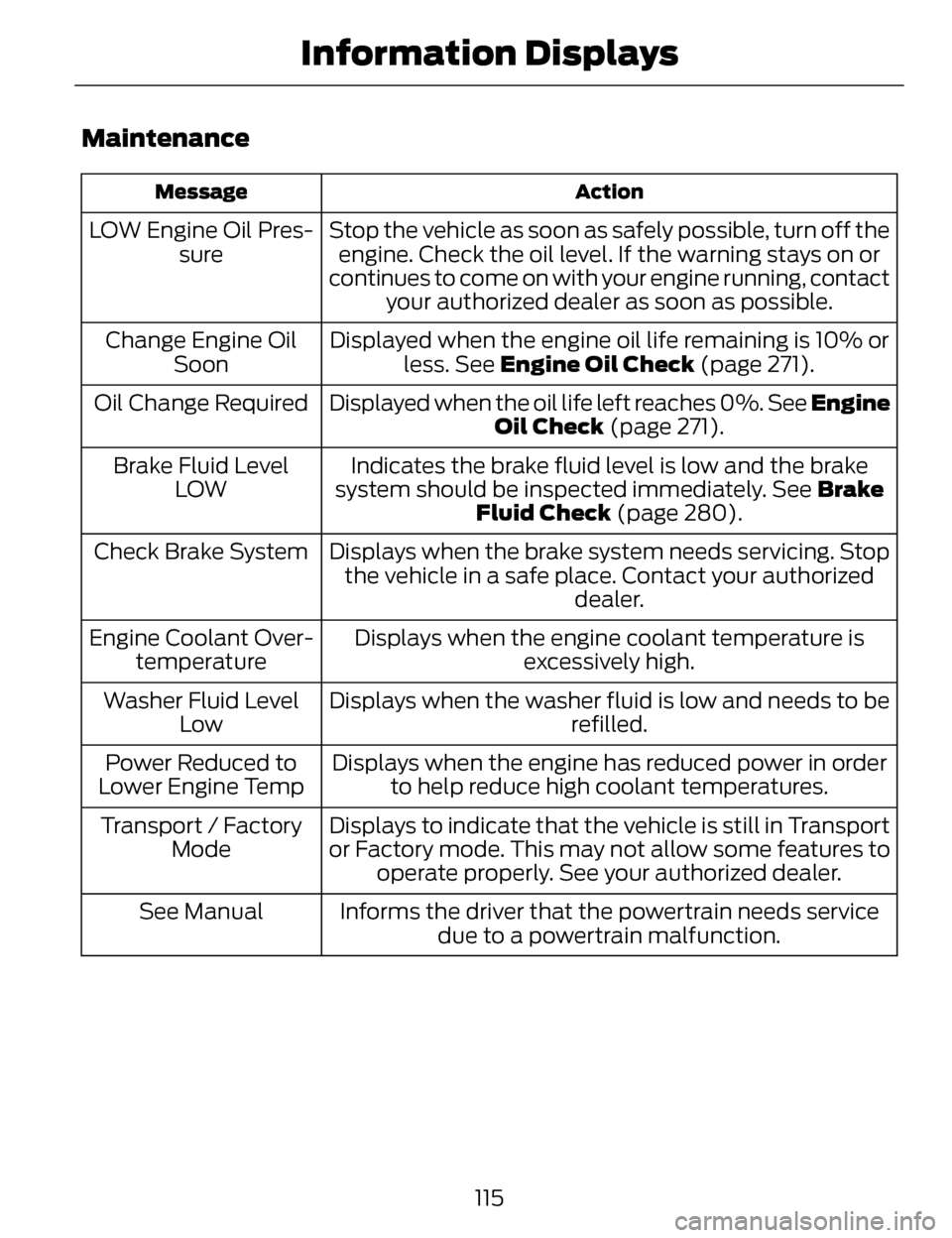
Maintenance
Action
Message
Stop the vehicle as soon as safely possible, turn off the
engine. Check the oil level. If the warning stays on or
continues to come on with your engine running, contact your authorized dealer as soon as possible.
LOW Engine Oil Pres-
sure
Displayed when the engine oil life remaining is 10% orless. See Engine Oil Check (page 271).
Change Engine Oil
Soon
Displayed when the oil life left reaches 0%. See Engine Oil Check (page 271).
Oil Change Required
Indicates the brake fluid level is low and the brake
system should be inspected immediately. See Brake
Fluid Check (page 280).
Brake Fluid Level
LOW
Displays when the brake system needs servicing. Stopthe vehicle in a safe place. Contact your authorized dealer.
Check Brake System
Displays when the engine coolant temperature isexcessively high.
Engine Coolant Over-
temperature
Displays when the washer fluid is low and needs to be refilled.
Washer Fluid Level
Low
Displays when the engine has reduced power in orderto help reduce high coolant temperatures.
Power Reduced to
Lower Engine Temp
Displays to indicate that the vehicle is still in Transport
or Factory mode. This may not allow some features tooperate properly. See your authorized dealer.
Transport / Factory
Mode
Informs the driver that the powertrain needs servicedue to a powertrain malfunction.
See Manual
115
Information Displays
Page 158 of 468
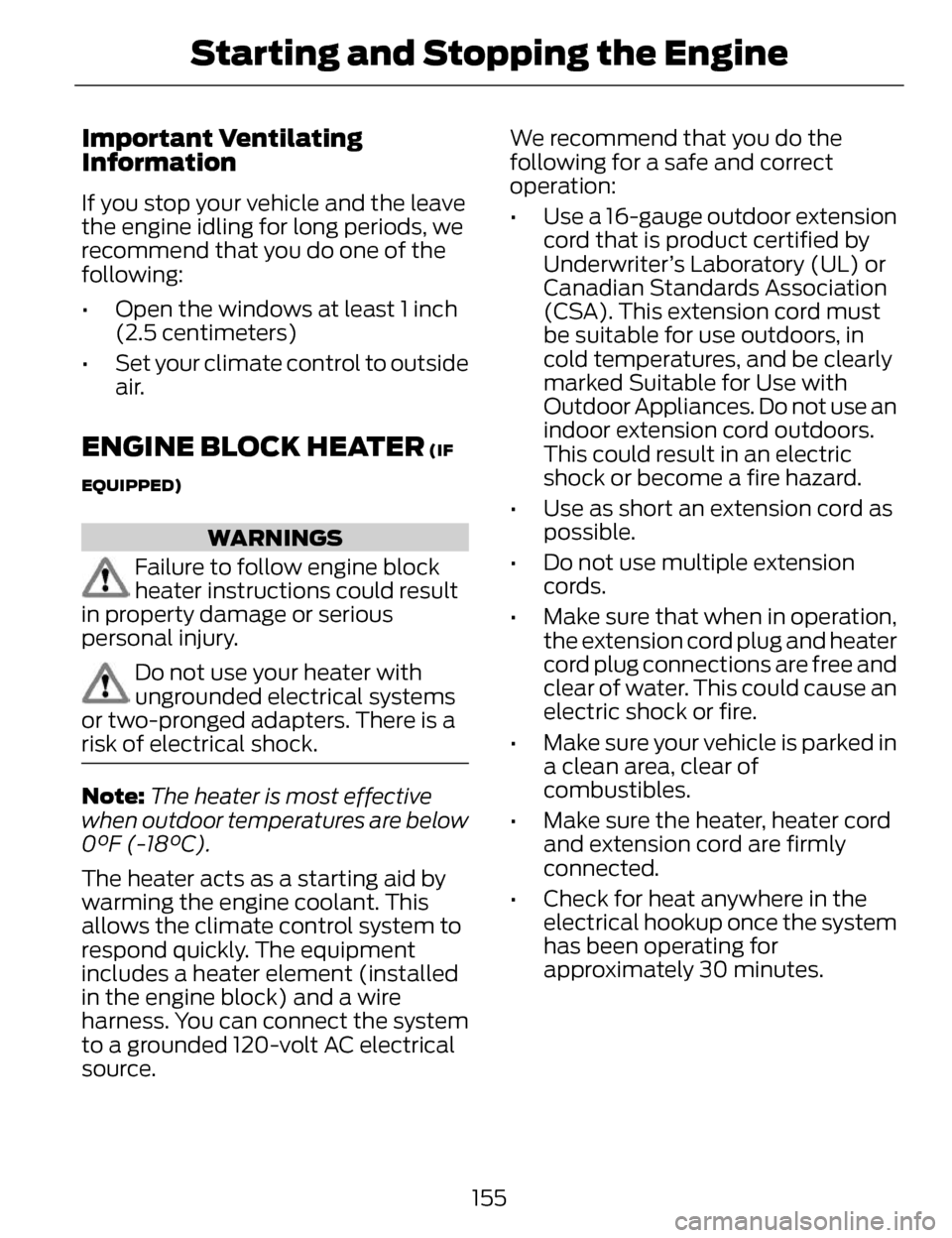
Important Ventilating
Information
If you stop your vehicle and the leave
the engine idling for long periods, we
recommend that you do one of the
following:
• Open the windows at least 1 inch(2.5 centimeters)
• Set your climate control to outside air.
ENGINE BLOCK HEATER (IF
EQUIPPED)
WARNINGS
Failure to follow engine block
heater instructions could result
in property damage or serious
personal injury.
Do not use your heater with
ungrounded electrical systems
or two-pronged adapters. There is a
risk of electrical shock.
Note: The heater is most effective
when outdoor temperatures are below
0°F (-18°C).
The heater acts as a starting aid by
warming the engine coolant. This
allows the climate control system to
respond quickly. The equipment
includes a heater element (installed
in the engine block) and a wire
harness. You can connect the system
to a grounded 120-volt AC electrical
source. We recommend that you do the
following for a safe and correct
operation:
• Use a 16-gauge outdoor extension
cord that is product certified by
Underwriter’s Laboratory (UL) or
Canadian Standards Association
(CSA). This extension cord must
be suitable for use outdoors, in
cold temperatures, and be clearly
marked Suitable for Use with
Outdoor Appliances. Do not use an
indoor extension cord outdoors.
This could result in an electric
shock or become a fire hazard.
• Use as short an extension cord as possible.
• Do not use multiple extension cords.
• Make sure that when in operation, the extension cord plug and heater
cord plug connections are free and
clear of water. This could cause an
electric shock or fire.
• Make sure your vehicle is parked in a clean area, clear of
combustibles.
• Make sure the heater, heater cord and extension cord are firmly
connected.
• Check for heat anywhere in the electrical hookup once the system
has been operating for
approximately 30 minutes.
155
Starting and Stopping the Engine
Page 277 of 468
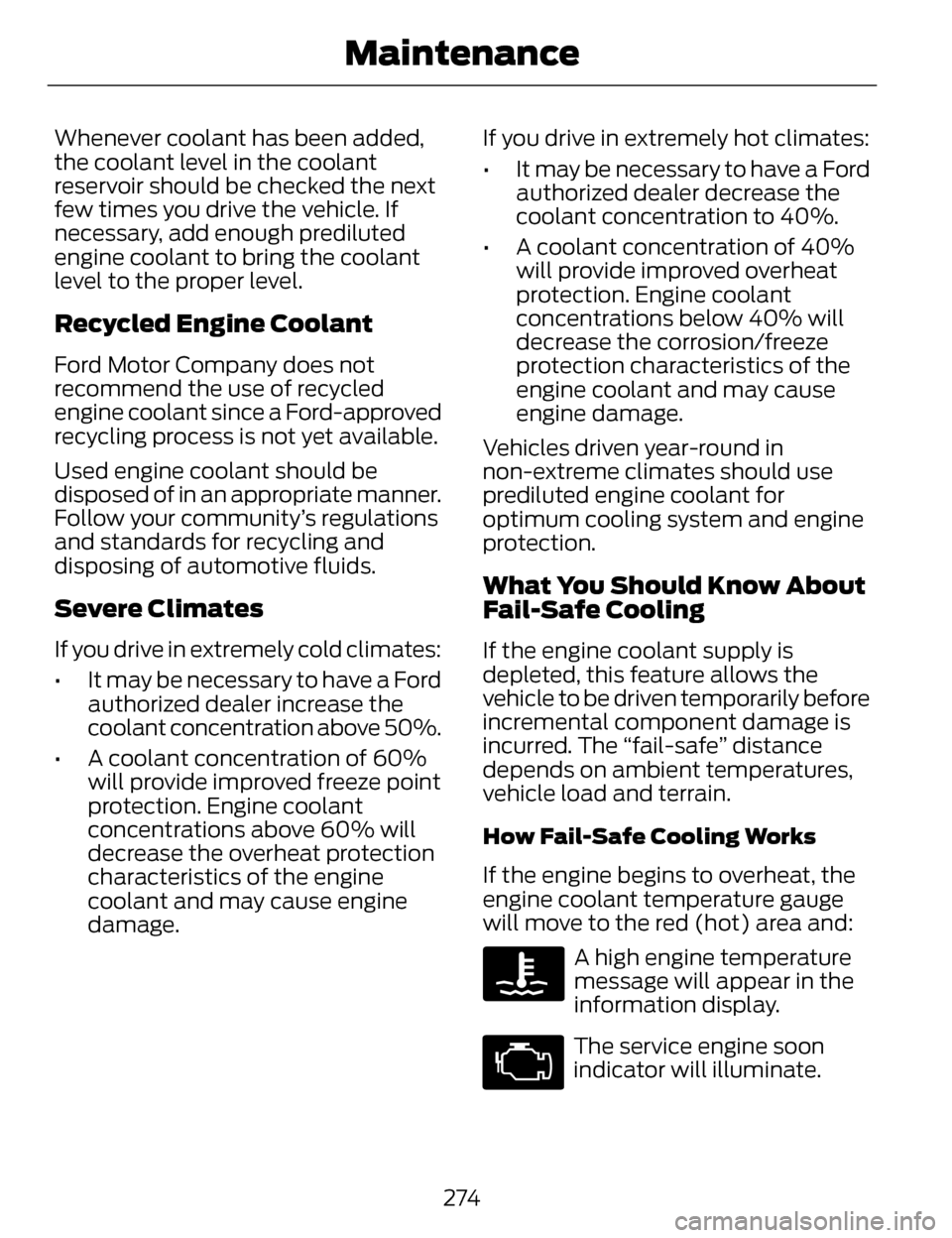
Whenever coolant has been added,
the coolant level in the coolant
reservoir should be checked the next
few times you drive the vehicle. If
necessary, add enough prediluted
engine coolant to bring the coolant
level to the proper level.
Recycled Engine Coolant
Ford Motor Company does not
recommend the use of recycled
engine coolant since a Ford-approved
recycling process is not yet available.
Used engine coolant should be
disposed of in an appropriate manner.
Follow your community’s regulations
and standards for recycling and
disposing of automotive fluids.
Severe Climates
If you drive in extremely cold climates:
• It may be necessary to have a Fordauthorized dealer increase the
coolant concentration above 50%.
• A coolant concentration of 60% will provide improved freeze point
protection. Engine coolant
concentrations above 60% will
decrease the overheat protection
characteristics of the engine
coolant and may cause engine
damage. If you drive in extremely hot climates:
• It may be necessary to have a Ford
authorized dealer decrease the
coolant concentration to 40%.
• A coolant concentration of 40% will provide improved overheat
protection. Engine coolant
concentrations below 40% will
decrease the corrosion/freeze
protection characteristics of the
engine coolant and may cause
engine damage.
Vehicles driven year-round in
non-extreme climates should use
prediluted engine coolant for
optimum cooling system and engine
protection.
What You Should Know About
Fail-Safe Cooling
If the engine coolant supply is
depleted, this feature allows the
vehicle to be driven temporarily before
incremental component damage is
incurred. The “fail-safe” distance
depends on ambient temperatures,
vehicle load and terrain.
How Fail-Safe Cooling Works
If the engine begins to overheat, the
engine coolant temperature gauge
will move to the red (hot) area and:
A high engine temperature
message will appear in the
information display.
The service engine soon
indicator will illuminate.
274
Maintenance
Page 278 of 468
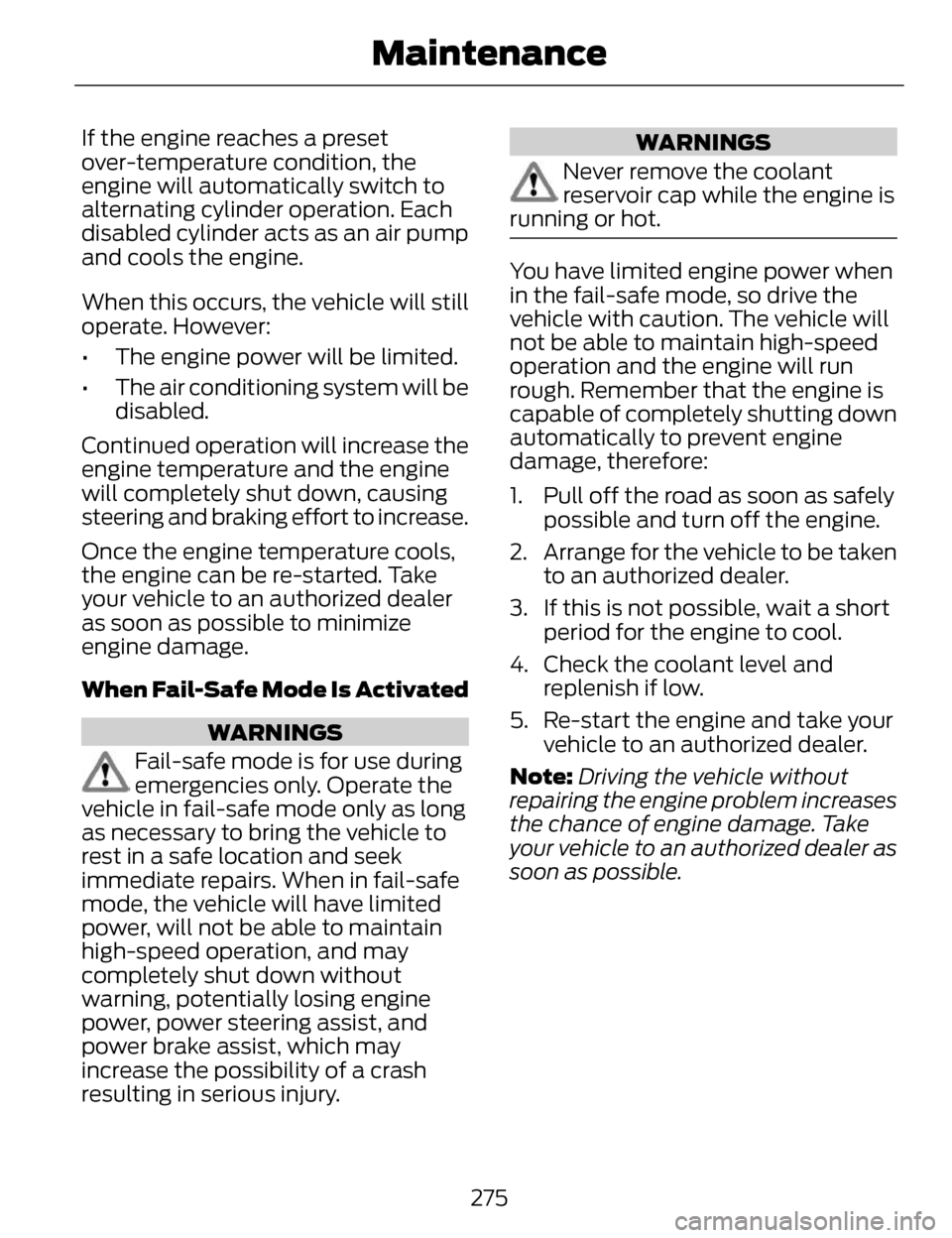
If the engine reaches a preset
over-temperature condition, the
engine will automatically switch to
alternating cylinder operation. Each
disabled cylinder acts as an air pump
and cools the engine.
When this occurs, the vehicle will still
operate. However:
• The engine power will be limited.
• The air conditioning system will bedisabled.
Continued operation will increase the
engine temperature and the engine
will completely shut down, causing
steering and braking effort to increase.
Once the engine temperature cools,
the engine can be re-started. Take
your vehicle to an authorized dealer
as soon as possible to minimize
engine damage.
When Fail-Safe Mode Is Activated
WARNINGS
Fail-safe mode is for use during
emergencies only. Operate the
vehicle in fail-safe mode only as long
as necessary to bring the vehicle to
rest in a safe location and seek
immediate repairs. When in fail-safe
mode, the vehicle will have limited
power, will not be able to maintain
high-speed operation, and may
completely shut down without
warning, potentially losing engine
power, power steering assist, and
power brake assist, which may
increase the possibility of a crash
resulting in serious injury.
WARNINGS
Never remove the coolant
reservoir cap while the engine is
running or hot.
You have limited engine power when
in the fail-safe mode, so drive the
vehicle with caution. The vehicle will
not be able to maintain high-speed
operation and the engine will run
rough. Remember that the engine is
capable of completely shutting down
automatically to prevent engine
damage, therefore:
1. Pull off the road as soon as safely possible and turn off the engine.
2. Arrange for the vehicle to be taken to an authorized dealer.
3. If this is not possible, wait a short period for the engine to cool.
4. Check the coolant level and replenish if low.
5. Re-start the engine and take your vehicle to an authorized dealer.
Note: Driving the vehicle without
repairing the engine problem increases
the chance of engine damage. Take
your vehicle to an authorized dealer as
soon as possible.
275
Maintenance
Page 298 of 468
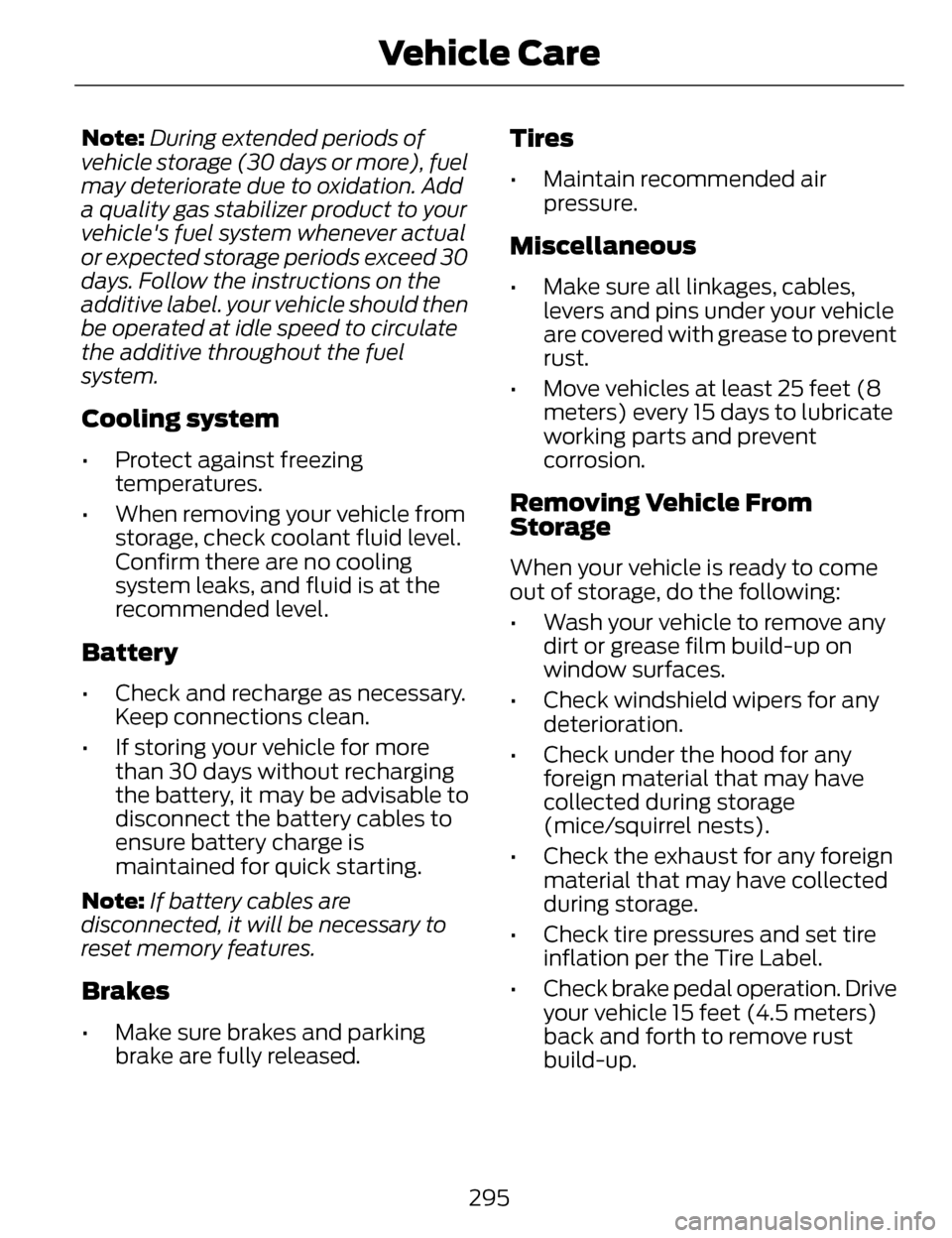
Note:During extended periods of
vehicle storage (30 days or more), fuel
may deteriorate due to oxidation. Add
a quality gas stabilizer product to your
vehicle's fuel system whenever actual
or expected storage periods exceed 30
days. Follow the instructions on the
additive label. your vehicle should then
be operated at idle speed to circulate
the additive throughout the fuel
system.
Cooling system
• Protect against freezing temperatures.
• When removing your vehicle from storage, check coolant fluid level.
Confirm there are no cooling
system leaks, and fluid is at the
recommended level.
Battery
• Check and recharge as necessary.Keep connections clean.
• If storing your vehicle for more than 30 days without recharging
the battery, it may be advisable to
disconnect the battery cables to
ensure battery charge is
maintained for quick starting.
Note: If battery cables are
disconnected, it will be necessary to
reset memory features.
Brakes
• Make sure brakes and parking brake are fully released.
Tires
• Maintain recommended airpressure.
Miscellaneous
• Make sure all linkages, cables,levers and pins under your vehicle
are covered with grease to prevent
rust.
• Move vehicles at least 25 feet (8 meters) every 15 days to lubricate
working parts and prevent
corrosion.
Removing Vehicle From
Storage
When your vehicle is ready to come
out of storage, do the following:
• Wash your vehicle to remove anydirt or grease film build-up on
window surfaces.
• Check windshield wipers for any deterioration.
• Check under the hood for any foreign material that may have
collected during storage
(mice/squirrel nests).
• Check the exhaust for any foreign material that may have collected
during storage.
• Check tire pressures and set tire inflation per the Tire Label.
• Check brake pedal operation. Drive your vehicle 15 feet (4.5 meters)
back and forth to remove rust
build-up.
295
Vehicle Care
Page 459 of 468
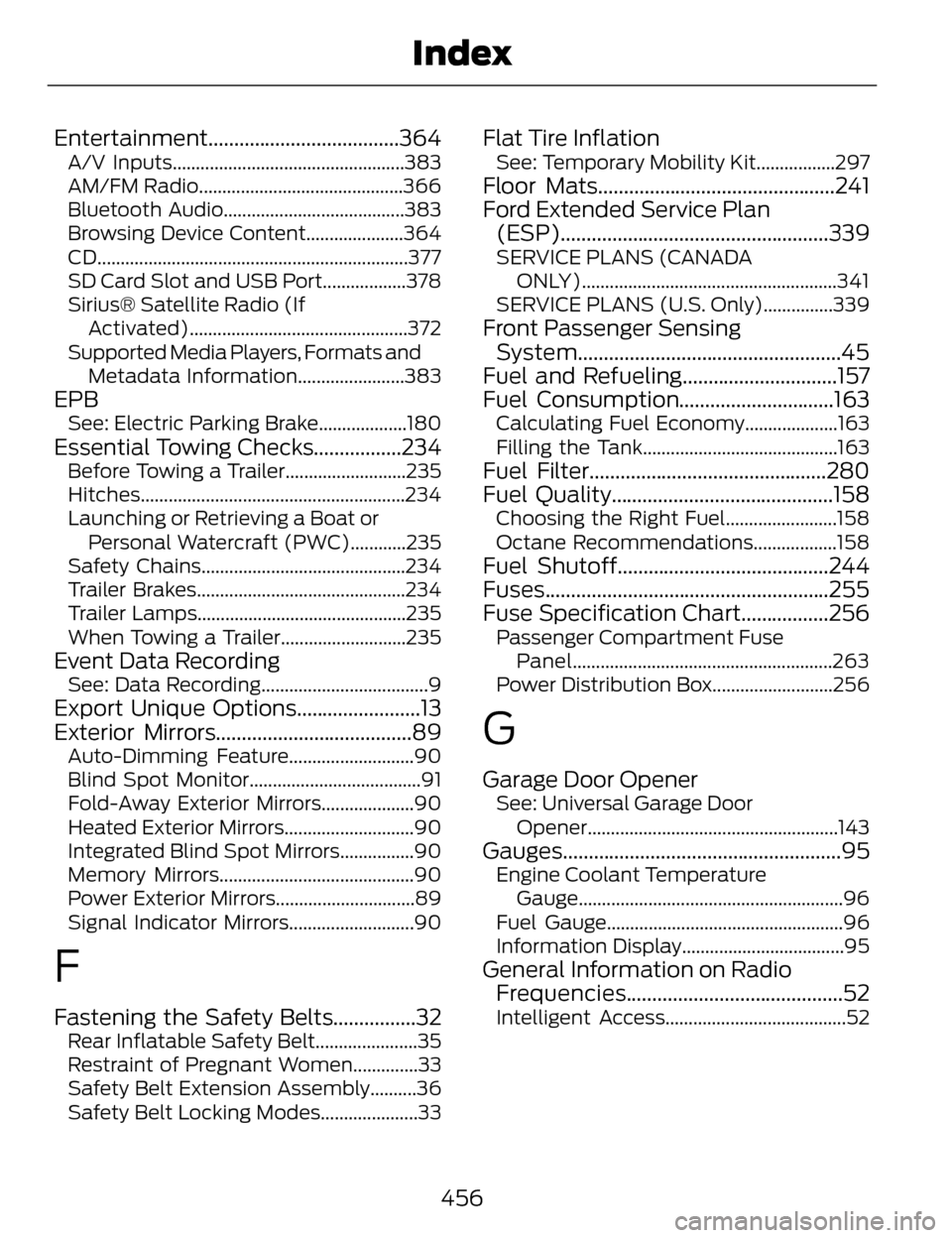
Entertainment.....................................364A/V Inputs..................................................383
AM/FM Radio............................................366
Bluetooth Audio.......................................383
Browsing Device Content.....................364
CD...................................................................377
SD Card Slot and USB Port..................378
Sirius® Satellite Radio (IfActivated)...............................................372
Supported Media Players, Formats and Metadata Information.......................383
EPBSee: Electric Parking Brake...................180
Essential Towing Checks.................234Before Towing a Trailer..........................235
Hitches.........................................................234
Launching or Retrieving a Boat orPersonal Watercraft (PWC)............235
Safety Chains............................................234
Trailer Brakes.............................................234
Trailer Lamps.............................................235
When Towing a Trailer...........................235
Event Data RecordingSee: Data Recording....................................9
Export Unique Options........................13
Exterior Mirrors......................................89
Auto-Dimming Feature...........................90
Blind Spot Monitor.....................................91
Fold-Away Exterior Mirrors....................90
Heated Exterior Mirrors............................90
Integrated Blind Spot Mirrors................90
Memory Mirrors..........................................90
Power Exterior Mirrors..............................89
Signal Indicator Mirrors...........................90
F
Fastening the Safety Belts................32Rear Inflatable Safety Belt......................35
Restraint of Pregnant Women..............33
Safety Belt Extension Assembly..........36
Safety Belt Locking Modes.....................33
Flat Tire InflationSee: Temporary Mobility Kit.................297
Floor Mats..............................................241
Ford Extended Service Plan (ESP)....................................................339
SERVICE PLANS (CANADA
ONLY).......................................................341
SERVICE PLANS (U.S. Only)...............339
Front Passenger Sensing System...................................................45
Fuel and Refueling..............................157
Fuel Consumption..............................163
Calculating Fuel Economy....................163
Filling the Tank..........................................163
Fuel Filter..............................................280
Fuel Quality...........................................158
Choosing the Right Fuel........................158
Octane Recommendations..................158
Fuel Shutoff.........................................244
Fuses.......................................................255
Fuse Specification Chart.................256
Passenger Compartment Fuse
Panel........................................................263
Power Distribution Box..........................256
G
Garage Door OpenerSee: Universal Garage Door Opener......................................................143
Gauges......................................................95Engine Coolant TemperatureGauge.........................................................96
Fuel Gauge...................................................96
Information Display...................................95
General Information on Radio Frequencies..........................................52
Intelligent Access.......................................52
456
Index